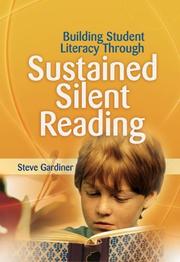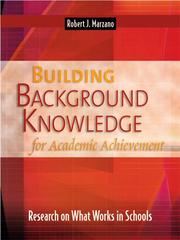| Listing 1 - 5 of 5 |
Sort by
|
Book
ISBN: 039808677X 9780398086770 9780398086763 0398086761 Year: 2011 Publisher: Springfield, Ill.
Abstract | Keywords | Export | Availability | Bookmark
 Loading...
Loading...Choose an application
- Reference Manager
- EndNote
- RefWorks (Direct export to RefWorks)
It is the goal of this book to provide unique and helpful information to reading and curriculum specialists who are looking for ways to improve the silent reading proficiency of their students. While the background information is, at times, technical, the recommendations as to the skill areas that require improvement as well as the computer techniques that can produce this improvement will prove extremely helpful in planning for a more comprehensive reading proficiency course of instruction. Reading and tutoring centers will naturally be interested in both the diagnostic eye-movement recording

ISBN: 9786610933303 1416603352 1416603336 1280933305 9781416603337 9781416603344 1416603344 9781416602262 1416602267 9781416603351 9781280933301 6610933308 Year: 2005 Publisher: Alexandria, Va. Association for Supervision and Curriculum Development
Abstract | Keywords | Export | Availability | Bookmark
 Loading...
Loading...Choose an application
- Reference Manager
- EndNote
- RefWorks (Direct export to RefWorks)
Building Student Literacy Through Sustained Silent Reading offers a powerful solution for teachers who want to improve their students' reading ability: Let students choose what they read and give them the time to read it.For 27 years, high school teacher Steve Gardiner has used the sustained silent reading (SSR) program in his English classes to help students of all abilities and backgrounds improve their literacy. Gardiner writes with refreshing candor about his own experiences developing a sustained silent reading program. He demonstrates convincingly that giving students 15 minutes of uninterrupted reading time each day can help them discover their own abilities and develop enduring reading habits.Gardiner also explores SSR's effect on the various dimensions of literacy-reading and writing proficiency, vocabulary and spelling skills, and content comprehension-by summarizing current research and sharing feedback from teachers, students, and administrators. Finally, he demonstrates how teachers can adapt SSR for their classes' unique needs without interfering with mandated curriculum or lesson plans.In an environment where reading is an essential part of all subjects, Building Student Literacy Through Sustained Silent Reading shows how a simple and inexpensive program can not only help students achieve greater success in school, but give them a valuable gift: the joy of reading.
Silent reading --- Language arts --- Reading

ISBN: 9786610933198 1280933194 1416602828 1416600558 9781416600558 9781416602828 9780871209726 0871209721 9781416600565 1416600566 6610933197 9781280933196 1416615806 Year: 2004 Publisher: Alexandria, Va. : Association for Supervision and Curriculum Development,
Abstract | Keywords | Export | Availability | Bookmark
 Loading...
Loading...Choose an application
- Reference Manager
- EndNote
- RefWorks (Direct export to RefWorks)
Explains why insufficient background knowledge is a chronic cause of low achievement, and describes how a carefully structured combination of two approaches--sustained silent reading and instruction in subject-specific vocabulary--can help rescue low achievers and boost the academic performance of all students.
Education --- Social Sciences --- Theory & Practice of Education --- Academic achievement --- School supervision --- Silent reading --- Vocabulary --- Study and teaching.
Book
ISBN: 1442684801 9781442684805 9780802093646 0802093647 Year: 2007 Publisher: Toronto
Abstract | Keywords | Export | Availability | Bookmark
 Loading...
Loading...Choose an application
- Reference Manager
- EndNote
- RefWorks (Direct export to RefWorks)
Based on a wealth of compelling arguments, Silent Reading and the Birth of the Narrator is an important addition to literary studies, eighteenth-century history, and book and print culture.
Silent reading --- Books and reading --- Narration (Rhetoric) --- Appraisal of books --- Books --- Choice of books --- Evaluation of literature --- Literature --- Reading, Choice of --- Reading and books --- Reading habits --- Reading public --- Reading --- Reading interests --- Reading promotion --- History --- Appraisal --- Evaluation --- Rhetoric --- Discourse analysis, Narrative --- Narratees (Rhetoric)
Book
Year: 2021 Publisher: Basel, Switzerland MDPI - Multidisciplinary Digital Publishing Institute
Abstract | Keywords | Export | Availability | Bookmark
 Loading...
Loading...Choose an application
- Reference Manager
- EndNote
- RefWorks (Direct export to RefWorks)
Reading fluency has been identified as a key component of proficient reading. Research has consistently demonstrated significant and substantial correlations between reading fluency and overall reading achievement. Despite the great potential for fluency to have a significant outcome on students’ reading achievement, it continues to be not well understood by teachers, school administrators and policy makers. The chapters in this volume examine reading fluency from a variety of perspectives. The initial chapter sketches the history of fluency as a literacy instruction component. Following chapters examine recent studies and approaches to reading fluency, followed by chapters that explore actual fluency instruction models and the impact of fluency instruction. Assessment of reading fluency is critical for monitoring progress and identifying students in need of intervention. Two articles on assessment, one focused on word recognition and the other on prosody, expand our understanding of fluency measurement. Finally, a study from Turkey explores the relationship of various reading competencies, including fluency, in an integrated model of reading. Our hope for this volume is that it may spark a renewed interest in research into reading fluency and fluency instruction and move toward making fluency instruction an even more integral part of all literacy instruction.
curriculum-based measurement --- fluency --- silent reading --- word recognition skills --- item response theory --- interventions --- oral reading fluency --- reading comprehension --- reading difficulties --- systematic review --- struggling readers --- reading motivation --- learning support --- socioeconomic status --- reading intervention --- reading fluency --- prosody --- NAEP --- MDFS --- spectrographic measurement --- KAPS model --- comprehension strategy use --- background knowledge --- repeated reading --- wide reading --- challenging texts --- oral reading --- academic achievement --- comprehension --- reading --- fluency development lesson
| Listing 1 - 5 of 5 |
Sort by
|

 Search
Search Feedback
Feedback About UniCat
About UniCat  Help
Help News
News